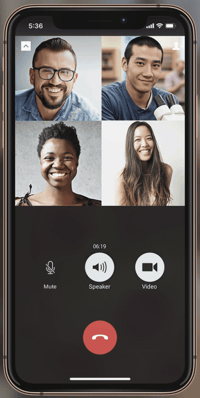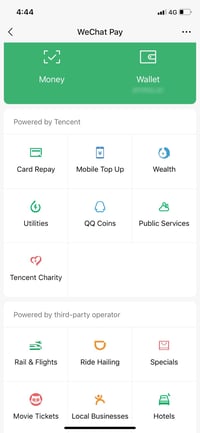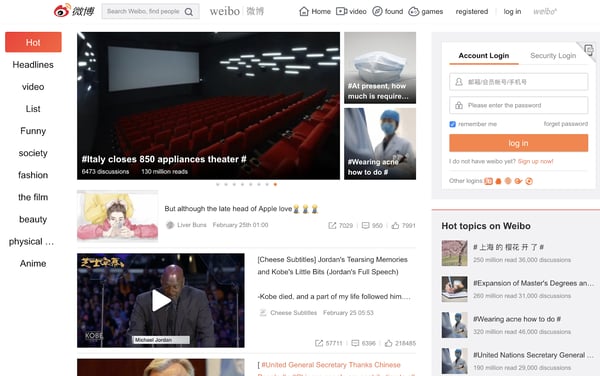8 Social Media Platforms That Weren't Founded in the U.S.
In 2018, North America discovered a viral new app called TikTok. Within just a year and a half of its launch, it reportedly grew to over 800 million active users.
As tech journalists and bloggers dug into the origin of the odd video app, some were surprised to discover that TikTok, which took America by storm, was actually inspired by an app created by the same company in China.
→ Free Download: Social Media Calendar Template [Access Now]
Researching social media platforms not founded in the U.S. can be helpful when trying to learn about audiences that live in other countries, especially those that live in highly censored areas like China or Russia. In areas like these, where people might not be able to access common U.S.-based networks, like Facebook or YouTube, tech companies have built their own social media empires.
Whether you're interested in international marketing, or just want to learn more about how audiences around the world interact with the internet, learning about the top global platforms that weren't created in Silicon Valley can be an eye-opening experience.
Below, I'll walk you through eight of the most popular social media platforms around the globe, including TikTok's origin platform -- Douyin.
8 of the Biggest Global Social Media Platforms
QZone and QQ
Owner: Tencent
Origin: China (Available globally, Chinese language-only)
Name's Origin: QZone and QQ were shortened from the original name, OICQ. The O stood for "open" while ICQ is an instant message term that sounds like "I Seek You" when said allowed.
Reported Users: 517 million active users on QZone with 653 million monthly users on QQ.
QZone is a social media channel while QQ is a messaging app that links to a QZone account. The two apps serve as an alternative to Facebook in countries like China and South Korea, where the U.S. platform is blocked.
The overall platform's story began in 1999 when QQ launched as a desktop messaging site. QZone, a social media site and app, launched in 2005. In 2019, as mobile-first mindsets grew in millennial and Gen Z audiences, Tencent transformed the QQ website into a standalone app. QZone still serves as a social media platform while QQ is now similar to the Facebook Messenger app.
To help you better visualize how people have used QQ and QZone, here's a quick analogy:
When U.S. millennials like me were children, we raced home from school to message our friends on AIM. Then, as we reached our high school years, we ventured onto Facebook, where we could message people, create a profile, and post updates.
Meanwhile, in China, people in my age group might have messaged friends on QQ's messaging website instead of AIM. Now, QQ users might use its sister app -- QZone -- for a social media experience that's comparable to Facebook. Then, to message friends, they use QQ.
Here's an example of a current QZone profile that shows just how similar the platform is to Facebook:

On QZone, users are encouraged to publish posts, videos, or even music. Like Facebook, they can also connect with friends, see a feed of updates, comment, share or react to posts, and update cover or profile photos.
The QQ and QZone are great examples of a social media brand that gained traction long before we signed on to well-known platforms owned by U.S. tech firms. The usership of QQ and QZone might be so strong in China because young audiences discovered the brand for its messaging tool and were able to join and enjoy its full social media network later on.
Although Facebook launched 2004, one year before QZone came out, Tencent had already captured the millennial demographic with QQ, figured out how to grow its product competitively with QZone, and continued to add features to pull in Gen Z audiences.
While QZone and QQ seem like Facebook alternatives, their history of growth is fairly parallel. And, as one of the ten biggest social media platforms globally, QZone is worth knowing about if you plan to market to Asian territories with heavy censorship.
WeChat/Weixin
Owner: Tencent
Origin: China (Available globally)
Name's Origin: The app's original name was Weixin, which translates to "micro letters." In a play to become a more globally used app, Weixin rebranded to WeChat in 2012,
Reported Users: 1 billion active users
WeChat launched in 2011, before competitors like Kik and WhatsApp. The messaging app was rolled out by Tencent, which also created QZone and QQ.
Similarly to WhatsApp, WeChat allows free text-based chats and voice calls. It also has a Moments feature similar to Instagram or Facebook Stories. Like many U.S. platforms, you can place fun animated stickers and filters on images or videos sent within the app.
To join WeChat, users need to know someone on the platform and have them scan an activation code that a user receives when logging in for the first time.
Once users are logged in, they can access WeChat's messaging feature, send video messages to friends, and host virtual phone calls with one or more contacts.

Aside from using the platform for friend-to-friend communication, users can also take advantage of more entertaining features. For example, while one feature allows people to play in-app games live against friends, others include video or photo filters that can be used in chats or video calls.
Here's a quick video that shows a popular game being played on the WeChat app:
https://www.youtube.com/watch?v=lXhLXBTm2tc
WeChat also connects to a number of third-party or Tencent-owned apps so that a user can take on multiple tasks, like hailing a ride or paying friends money, directly from WeChat.

Source
At this point, Facebook, Snapchat, WhatsApp, and other major social media apps are using a similar strategy of pulling additional features into their platforms to keep users logged in longer. For example, many of today's top messengers allow group video calls, offer in-app games, or let users send money.
Weibo (Also known as Sina Weibo)
Owner: Sina Corp.
Origin: China (Available globally with text in Chinese.)
Platform Name Translation: Loosely translates "microblogging."
Reported Users: Projected to hit 500 million monthly active users in 2020
Weibo, also called Sina Weibo, is the biggest Chinese microblogging and social media platform. The social channel made news in 2017 when it reached more monthly active users than Twitter. Since then the app's continued to grow. Reports suggest that more than 30% of Chinese internet users now have an account on the platform.
When you visit the website, it's automatically in Chinese. However, you can use Google Chrome's translator to convert the text to different languages. To give you a better idea of how Weibo works, here's what its desktop site looks like with the English translation turned on.

Like Twitter, Weibo offers a central feed where you can see the latest or highest performing posts. To toggle through different types of posts, you can click a category on the list in the left sidebar. On the left, you can log in to an account and see "Hot Topics" similar to Twitter's "Trending Topics." If you continue to scroll down, you'll also see a box that allows you to search for people -- similarly to Twitter's "Who to follow" block.
To help you see just how similar these two platforms are, here's a picture of Twitter's feed.
Comments
Post a Comment